- News
- Reviews
- Bikes
- Accessories
- Accessories - misc
- Computer mounts
- Bags
- Bar ends
- Bike bags & cases
- Bottle cages
- Bottles
- Cameras
- Car racks
- Child seats
- Computers
- Glasses
- GPS units
- Helmets
- Lights - front
- Lights - rear
- Lights - sets
- Locks
- Mirrors
- Mudguards
- Racks
- Pumps & CO2 inflators
- Puncture kits
- Reflectives
- Smart watches
- Stands and racks
- Trailers
- Clothing
- Components
- Bar tape & grips
- Bottom brackets
- Brake & gear cables
- Brake & STI levers
- Brake pads & spares
- Brakes
- Cassettes & freewheels
- Chains
- Chainsets & chainrings
- Derailleurs - front
- Derailleurs - rear
- Forks
- Gear levers & shifters
- Groupsets
- Handlebars & extensions
- Headsets
- Hubs
- Inner tubes
- Pedals
- Quick releases & skewers
- Saddles
- Seatposts
- Stems
- Wheels
- Tyres
- Health, fitness and nutrition
- Tools and workshop
- Miscellaneous
- Cross country mountain bikes
- Tubeless valves
- Buyers Guides
- Features
- Forum
- Recommends
- Podcast
review
£3,299.00
VERDICT:
Very good aluminium road bike that can match similarly priced carbon rivals in terms of weight, rigidity, and ride quality
Weight:
7,260g
Contact:
www.nemesisgb.com
At road.cc every product is thoroughly tested for as long as it takes to get a proper insight into how well it works. Our reviewers are experienced cyclists that we trust to be objective. While we strive to ensure that opinions expressed are backed up by facts, reviews are by their nature an informed opinion, not a definitive verdict. We don't intentionally try to break anything (except locks) but we do try to look for weak points in any design. The overall score is not just an average of the other scores: it reflects both a product's function and value – with value determined by how a product compares with items of similar spec, quality, and price.
What the road.cc scores meanGood scores are more common than bad, because fortunately good products are more common than bad.
- Exceptional
- Excellent
- Very Good
- Good
- Quite good
- Average
- Not so good
- Poor
- Bad
- Appalling
But why? Why would anyone buy a high-end road bike that's made from aluminium these days? That's what everyone will ask when you show up for the club run on a Principia REX. And the answer is that this bike is light, fast and comfortable, stacking up well against carbon alternatives...
I'll set out my stall right away: I couldn't care less what material is used for the frame. Well, you know, as long as it's not ivory or uranium or something. What I mean is, if it does its job, I'm not bothered if it's carbon fibre composite, aluminium alloy, cromo steel or recycled newspaper.
But aluminium is harsh, or course. Is it, though? That's one of those pieces of received wisdom that gets handed on from one rider to the next as some eternal truth of the universe... and it's not necessarily true. Sure, you can get harsh-feeling aluminium frames, but you can get harsh-feeling carbon frames too. I'm not buying into the idea that all aluminium bikes will leave you battered and bruised if you dare to ride them for more than an hour or two at a time.
The fact is, any manufacturer is going to struggle to make a frame as lightweight and stiff as a carbon fibre option with any other material. But it's not as simple as: a carbon bike is better than an aluminium bike.
That's what a lot of people think, though. '£3,000? You could get a carbon fibre bike for half that.' But that's no reason to dismiss the Principia REX out of hand. This bike has a lot to offer...

Frame and fork
The REX frame was first introduced back in 1998. That's a helluva long time ago in bike years. Of course, it has been updated considerably since then, the 2011 version being, obviously, the lightest and, obviously, the most vertically compliant ever, according to the manufacturer. Today's REX frame is actually 300g lighter than the original version, the 55cm model weighing just 1,140g. That would be light for a carbon bike. For an aluminium bike, it's amazing.
The frame is made from PMA Principia Magnum Tubing that's triple butted - meaning that the wall thicknesses vary according to their position in the frame. They're as thin as 0.9mm for saving weight up to 1.6mm at the joints.

Speaking of the joints, they're TIG welded using Principia's TiW2 (Tube Inserted Welding 2) technology in parts. Where the head tube and the top tube join, and where the seat tube meets the bottom bracket, rather than the tubes being slapped next to one another and welded together, one tube slots into the other. Principia reckon this allows smaller tolerances, better welds and a lower weight.
Principia use different sized tubing for different sized bikes, and if you think about it, that makes a lot of sense. Smaller frames are likely to be subject to smaller loads while larger frames need to be stronger and stiffer.
They alter the slope of the top tube according to frame size too. There's less of an angle on the larger sizes to keep down the amount of seat post extending out of the frame. Long seat posts are structurally weak and unaesthetic, according to Principia. That seat post, by the way, is 27.2mm in diameter on frame sizes up to 55cm to provide comfort for smaller riders, but it's beefed up to 31.6mm on our 57cm test model and the other large sizes for extra stiffness
The REX's frame looks a lot like it did back in 1998, based around large tubes with minimal shaping. The down tube, for example, is a mighty 51mm across (54mm on the 59 and 61cm models) and the seatstays are almost dead straight.
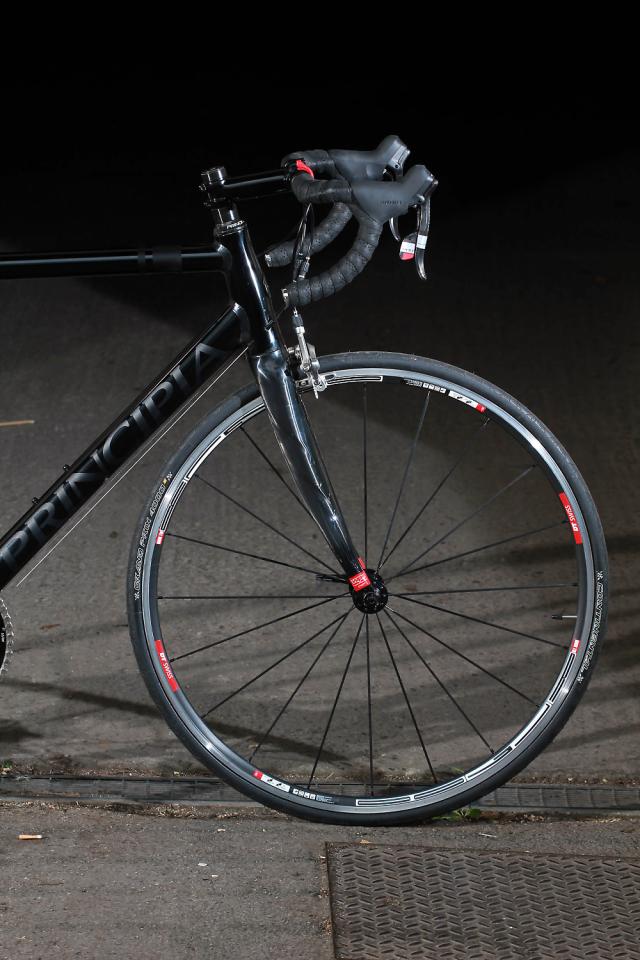
The main exception is the bulbous head tube which houses a 1 1/8in headset bearing up top before immediately swelling outward. As on many performance road bikes these days, the lower bearing is 1 1/2in for a significant amount of extra front-end rigidity. The gear cables tunnel through that head tube so you get inline barrel adjusters to fine-tune shifting.
As for the geometry, there's nothing crazy going on here, our 57cm test model coming with a 73 head angle and 73.5 seat angle. At 171mm, the head tube is about average length for a race machine of this size. The front end is certainly low enough for an efficient ride position, but not excessively. If you're used to a typical road bike set up, you'll have no worries.
The finish is worth a quick mention too. The Principia is anodized black with just a few subtle matt logos and details. Very classy, if you ask us, and lightweight, and it won't chip off. You might scratch it, but this bike should hold its good looks for a long time. Our test model is certainly looking in great nick after plenty of miles on the road.

Principia's own Flow fork is the brand's lightest ever at 320g. It's a full carbon monocoque with blades that head down virtually parallel to one another before kicking out to the dropouts at the last minute. By making the legs skinny (crossways) but deep (front to back), Principia reckon they've been able to maintain the lateral stiffness needed for stability while adding our good old friend vertical compliance for more comfort.
Components

The REX comes with an almost complete complement of parts from SRAM's top level Red range. You'll be familiar with the Double Tap shifting system by now. One short push on the right hand lever moves you up a gear (to a smaller sprocket), a longer push shifts you down - three sprockets at a time, if you like. It works great and I've never noticed the need for any more or less maintenance than with either Shimano or Campag. Which action you prefer is purely a matter of taste.
The dual pivot brakes are Red too although the chainset is an FSA K-Force Light MegaExo (68mm bottom bracket with external cups) with hollow monocoque composite crank arms and 53/39T chainrings. The carbon seatpost is K-Force too while the bar and stem are unbranded aluminium.

The wheels are DT Swiss R1700s which come with smooth bearings, 25mm deep rims and bladed spokes. They weigh 740g (f) and 910g (r), plus 76g for the skewers, so they're not mega-light but the quality is high. They'd cost about £600 if you bought them separately.
You can buy the REX with DT Swiss's carbon RRC1250 wheels - 33mm-section carbon clinchers, ceramic bearings, high-end hubs - if you prefer, although that'll set you back £5,599. The frame on its own is £1,399.
The ride

Our 57cm REX, less pedals, hit the road.cc scales at 7.26kg (15.97lb). That's light. The all-carbon £3,200 Wilier Triestina Gran Turismo that we tested recently was 7.65kg (16.83lb), for example, while last year's £3,000 Felt AR3 – admittedly a bike designed with aerodynamics in mind – was 7.58kg (16.68lb).
The £3,699 NeilPryde Diablo was lighter at 6.85kg (15.07lb), but the point is, in terms of weight, the Principia is there or thereabouts. Not that we're saying weight is the be all and end all - far from it - but the REX is very much in the mix.
That lack of weight results in a bike that feels full of life from the off. Fair enough, I can't remember the last time I rode a three grand bike that felt sluggish, but even taking price into account, the Principia is a spirited ride, gaining speed promptly when you fire up your quads.
The one reservation I have on that front is that the DT Swiss wheels are okay rather than spectacular. They're stiff enough, holding their shape well whether you're hammering out of the saddle or chucking the bike into a fast downhill corner, but they're just a tad heavy compared to the other components on the bike.
Saving rotational weight makes more of a difference to a bike's performance than saving weight elsewhere. You can't have top-line components throughout without bumping up the price, of course, but I'd rather have wheels 10% lighter, say, and take a hit somewhere else. But, a lot of people spending this kind of money are going to have their own favourite wheels anyway.
The REX still accelerates quickly and it's a good climber without any noticeable frame flex when you haul yourself out of the saddle and drive the pedals. In fact, it's remarkably rigid with all your power going straight into the cranks rather than into bending the frame off-centre. Principia might have lightened the frame since the early REX incarnations but they've retained all the rigidity for a solid, confident feel. It's not just on the climbs that this is a big plus; you get the benefit on the descents too, the REX tracking beautifully through both fast sweeper and the sharp stuff.
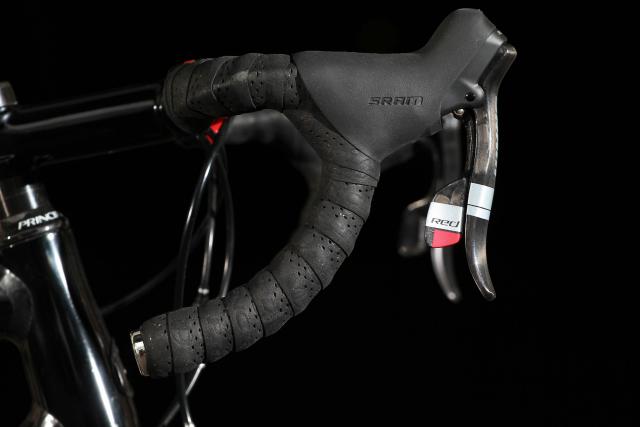
I really like the big handful of lever body you get with SRAM when you're riding on the hoods and, mounted to the Elit bars, you get an ultra-flat platform to work from up front. The levers are really easy to grab from the drops - they're adjustable for reach if you have small hands - while the lightweight brakes with their milled out shoes provided all the stopping power I needed in both wet and dry conditions.
Some people might be put off by the 53/39T chainring combo but it's in keeping with the racy character of the bike. You might yearn for a smaller inner chainring on really steep stuff or at the end of a long day in the saddle but... it's swings and roundabouts. The 53T outer means you can keep piling on the power at well over 40mph on a straight descent before your legs disappear into a blur.
The other thing to address here is comfort. There's a lot of nonsense written about bike comfort, particularly with regard to aluminium frames. A good saddle, bar tape, shorts and gloves make more difference than any amount of frame flex or damping in the fork. Of course, you can engineer the frame and forks to be more comfortable but that's far from the complete picture.
Anyway, I'll cut to the chase... the first ride I did on this bike was five hours. I got off it and felt fine. Next morning, I still felt fine, got back on and did another couple of hours. I still felt fine. It's not harsh. If anything, the front end, with the full carbon fork, transfers bumps in the road more directly than the back end, but harsh? Nah.
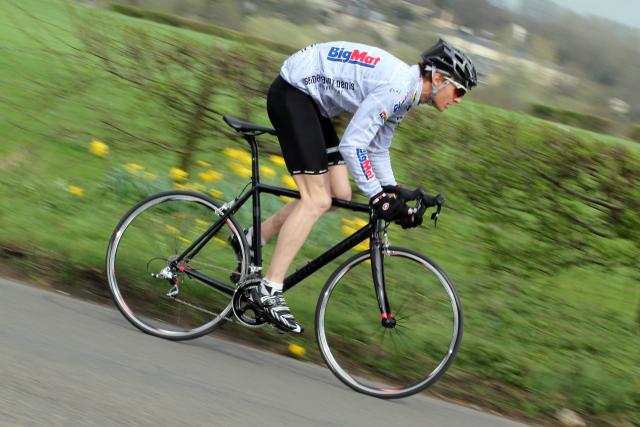
Gripes and moans? We always have a few. Well, as I said before, I'd rather have had slightly lighter wheels. And while we're on the subject of wheels, I got three - count 'em - punctures on this bike first time out. Why? Because the rim tape wasn't covering the spoke holes properly, or it was moving slightly when I got out of the saddle. Driving me nuts, it was. The last thing you check is that the rim tape isn't made of linguine. Anyway, it's hardly a massive problem in the overall scheme of things so I won't go on about it. I'll just sit here and stew. And then head down to the bike shop and buy myself some new tubes.
Overall, though, this is a really good bike that can match similarly-priced carbon rivals in terms of weight, rigidity and ride quality. In terms of cost, £3,299 is a big price tag for an aluminium bike. But take the frame material out of the equation. Is it a lot of money for a sub-16lb bike with a SRAM Red groupset and this level of performance? No, not really.
Cannondale's SuperSix HiMod SRAM Red, about a pound lighter, costs £3,499. The BMC Racemachine RM01, with a Red drivetrain and Force brakes, is £3,499 too, and it's maybe half a pound lighter than the Principia. There aren't all that many Red-equipped complete bikes that are cheaper (yes, we know they exist. And no, we're not getting into the debate over whether Red is overpriced compared to, say, Dura Ace right now!).
Okay, I'm playing devil's advocate a bit but you get the idea... It makes much more sense to compare the REX with bikes of a similar ilk, rather than with bikes that share a common frame material.
Would we say that the Principia has any advantage over a carbon bike by virtue of being aluminium? To be honest... no. But it doesn't lose out on account of the frame material either. The trouble is, we're not sure many people will buy an aluminium-framed bike at this price in a market where carbon is king.
Verdict
Very good aluminium road bike that can match similarly priced carbon rivals in terms of weight, rigidity, and ride quality
road.cc test report
Make and model: Principia REX
Size tested: 57cm
About the bike
State the frame and fork material and method of construction. List the components used to build up the bike.
The frame is triple butted aluminium alloy -heat treated Principia Magnum Aluminium -that's TIG welded. It's made using Principia's TiW2 technology (see the main text for details.
The fork is a full carbon fibre monocoque.
Tell us what the bike is for, and who it's aimed at. What do the manufacturers say about it? How does that compare to your own feelings about the bike?
Road riders/racers with a carbon allergy, presumably. It's built to a racy geometry.
Frame and fork
Overall rating for frame and fork
8/10
Tell us about the build quality and finish of the frame and fork?
The welds are neat and the anodized finish is classy
Tell us about the geometry of the frame and fork?
It's a fairly standard road bike geometry. There's no extended head tube or shortened top tube or anything like that. The top tube slopes only very slightly on the 57cm model we had. It's a steeper slope on smaller frame sizes.
How was the bike in terms of height and reach? How did it compare to other bikes of the same stated size?
Pretty standard.
Riding the bike
Was there any toe-clip overlap with the front wheel? If so, was it a problem?
None
Rate the bike for efficiency of power transfer:
9/10
Rate the bike for acceleration:
8/10
Rate the bike for sprinting:
9/10
Rate the bike for high speed stability:
8/10
Rate the bike for cruising speed stability:
8/10
Rate the bike for low speed stability:
8/10
Rate the bike for flat cornering:
8/10
Rate the bike for cornering on descents:
8/10
Rate the bike for climbing:
8/10
The drivetrain
Rate the drivetrain for performance:
9/10
Rate the drivetrain for durability:
8/10
Rate the drivetrain for weight:
9/10
Rate the drivetrain for value:
7/10
Wheels and tyres
Rate the wheels and tyres for performance:
7/10
Rate the wheels and tyres for durability:
8/10
Rate the wheels and tyres for weight:
7/10
Rate the wheels and tyres for comfort:
8/10
Rate the wheels and tyres for value:
7/10
Controls
Rate the controls for performance:
9/10
Rate the controls for durability:
8/10
Rate the controls for weight:
9/10
Rate the controls for comfort:
9/10
Rate the controls for value:
7/10
Your summary
Did you enjoy riding the bike? Yes
Would you consider buying the bike? I don't need another road bike right now, thanks
Would you recommend the bike to a friend? Yes
Rate the bike overall for performance:
8/10
Rate the bike overall for value:
8/10
About the tester
Age: 40 Height: 190cm Weight: 74kg
I've been riding for: Over 20 years I ride: Most days I would class myself as: Expert
I regularly do the following types of riding: time trialling, commuting, sportives, general fitness riding,
Mat has been in cycling media since 1996, on titles including BikeRadar, Total Bike, Total Mountain Bike, What Mountain Bike and Mountain Biking UK, and he has been editor of 220 Triathlon and Cycling Plus. Mat has been road.cc technical editor for over a decade, testing bikes, fettling the latest kit, and trying out the most up-to-the-minute clothing. He has won his category in Ironman UK 70.3 and finished on the podium in both marathons he has run. Mat is a Cambridge graduate who did a post-grad in magazine journalism, and he is a winner of the Cycling Media Award for Specialist Online Writer. Now over 50, he's riding road and gravel bikes most days for fun and fitness rather than training for competitions.
Latest Comments
- Mr Blackbird 5 sec ago
Re Thomas Voeckler's 1.13 HM, at age 45....
- Simon E 8 hours 51 min ago
Speak for yourself....
- David9694 8 hours 54 min ago
Public path across Christchurch civic centre car park could stop sale, claims Friar’s Cliff Residents Association...
- David9694 9 hours 46 min ago
Morrisons supermarket car park cordoned off after car crash https://www.theargus.co.uk/news/25002751.morrisons-supermarket-car-park-...
- Matt Page 10 hours 4 min ago
It sounds like the shoes you have are the Boa L6, and they work well, although the Li2 is better, especially with dual-dial shoes. ...
- Oldfatgit 10 hours 9 min ago
I'm going to admit that I thought that [sic] was an indication of a spelling mistake .. and only after looking it up, I realise that I was *sort*...
- Oldfatgit 10 hours 15 min ago
This is a confusing 'roundabout'...
- AidanR 11 hours 2 min ago
I wouldn't be so sure that he'll get away with this just because cops routinely shoot people and get off. The law is very different as effectively...
- Rendel Harris 12 hours 13 min ago
What he wrote is a direct word for word quote from the King James Bible, one of the very greatest achievements of written English in the history of...
- stonojnr 12 hours 18 min ago
From what I understood from lawyers, there's nothing preventing a charge of manslaughter being applied in addition to death by dangerous driving...



























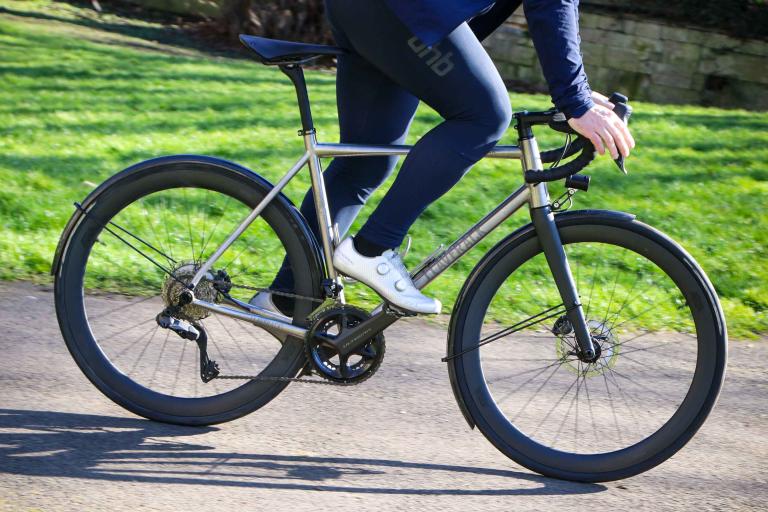


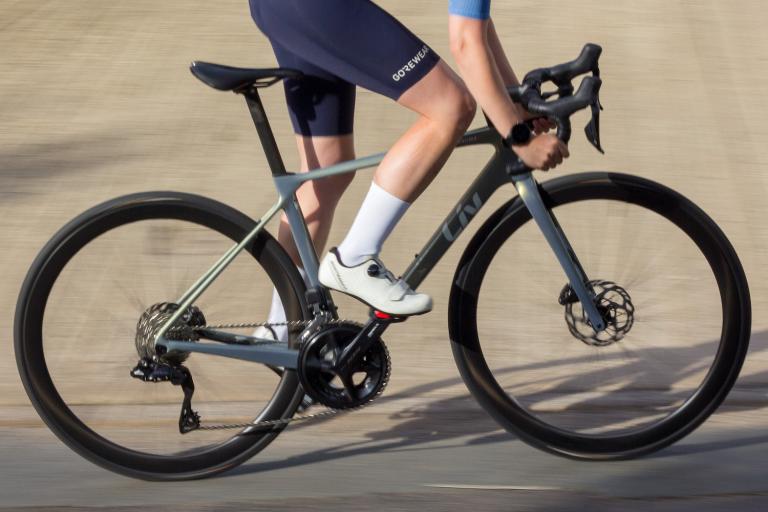
Add new comment
5 comments
thanks. just waiting for the finishing touches to arrive, Thomson seatpost and stem, hmmmmm loverly.
oh and a new 'road.cc' jersey will be the icing on the cake of course, them gonna be available sometime?
That is a really nice looking bike Fringe
ive just got/built up an older version, rides very nice too, not harsh at all, and didnt cost me anywhere close to 3 grand. think i'll keep it for a couple of years and then see what else is knocking around on various classifieds.."im not a bike 'for life' person"
IMG_0072.JPG
I've never had an aluminium bike that was so harsh I couldn't ride it all day long, or was so heavy it was a significant factor in my success, or lack thereof, in races. Nor have I ever spent as much as this on any bike, regardless of frame material. But I have crashed an aluminium bike and had to dispose of the frame, because it bent where a titanium one probably wouldn't have, and could not be cold set back into alignment like a steel one. Also, no amount of money can prevent the fatigue limit problem of aluminium alloys. Most people would probably get bored with riding the same bike long before that is a factor but, for me, 3300 quid is too much for an inherently disposable bike.
Surely your comments also apply to carbon fibre bikes too?